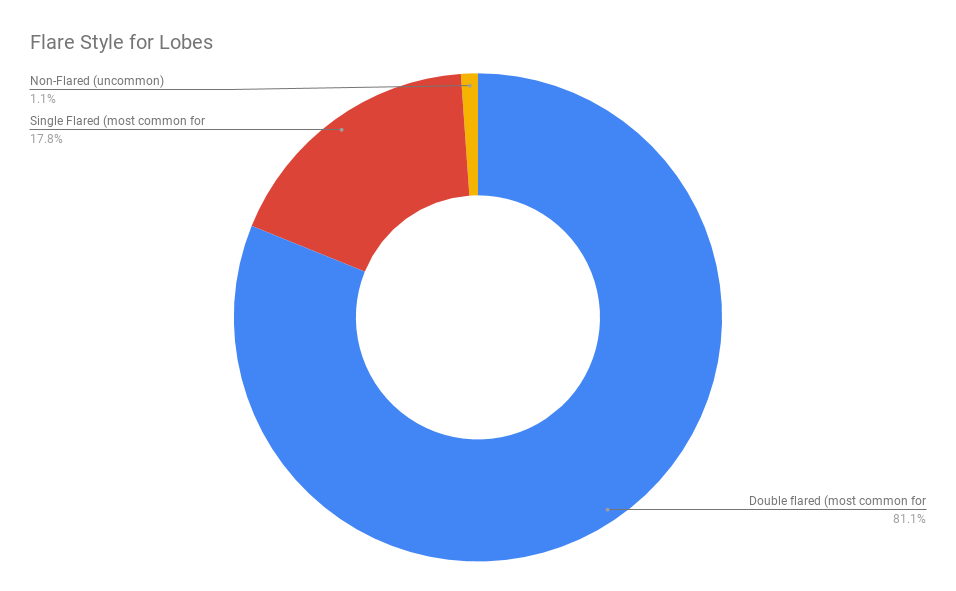Body Jewelry Consumer Survey 2019
Early this year, I set out to give independent makers and small businesses in the body jewelry industry a way to make smarter business decisions with analytics. We can look at our past sales and infer trends like our most popular sizes and styles, but I wanted to provide a broader look at the current size and buying patterns industry wide. After 16 years of business, I have enough sales records to see a general picture of my customers, but my data set is still limited. The goal of this survey is to create connections between size, style, and cost that allow us to make smart decisions based on what consumers are actively looking to purchase.
I was able to obtain 833 responses (as of 7/21/19) to a variety of questions that cover size, style, and buying habits for stretched ear lobe, cartilage, and lip piercing jewelry. Results are presented in tabular data as well as charts. For some questions with a wide range of answers, I've charted both the totals and the top range for more focus.
The link to the survey was shared on Instagram, Facebook, and Reddit on several dates, sometimes using charts of early results to start a dialogue and encourage responses. In the future I will also consider leveraging the reach of my email list and put more focus on other makers sharing future surveys among their own customer base.
Stretched Lobes: What's your size?
745 responses. There were no surprises here based on my historical data, but it's fascinating to see how the sizes relate to one another. It's my hope that these results help answer consumer questions about why small makers don't make stock in many "between" sizes, and many less popular larger sizes. The top 10 answers total 479 or 64% of the total respondents.


| Stretched Lobes: What's your size? | Count |
| 16mm (5/8") | 72 |
| 13mm (1/2") | 61 |
| 25mm (1" is 25.4mm, many prefer to round up to 26mm) | 58 |
| 19mm (3/4") | 53 |
| 8mm (0ga) | 49 |
| 9mm (00ga) | 42 |
| 14mm (9/16") | 41 |
| 22mm (7/8") | 38 |
| 26mm | 34 |
| 10mm | 31 |
| 38mm (1 1/2") | 29 |
| 51mm (2") | 29 |
| 6.5mm (2ga) | 28 |
| 32mm (1 1/4") | 23 |
| 11mm (7/16") | 16 |
| 3mm (8ga) | 16 |
| 5mm (4ga) | 15 |
| 20mm (13/16") | 13 |
| 12mm | 12 |
| 4mm (6ga) | 10 |
| 30mm (1 3/16") | 9 |
| 35mm (1 3/8") | 8 |
| 29mm (1 1/8") | 7 |
| 18mm | 6 |
| 28mm | 6 |
| 6mm | 6 |
| 41mm (1 5/8") | 5 |
| 7mm (1ga) | 5 |
| 17mm (11/16") | 3 |
| 34mm | 3 |
| 40mm (1 9/16") | 3 |
| 21mm | 2 |
| 24mm (15/16") | 2 |
| 42mm | 2 |
| 44mm (1 3/4") | 2 |
| 15mm | 1 |
| 27mm (1 1/16") | 1 |
| 36mm | 1 |
| 37mm (1 7/16") | 1 |
| 47mm | 1 |
| 50mm | 1 |
What jewelry shape do you prefer for lobes?
826 responses. I knew that round was going to be the majority, but I was surprised at how dramatic the numbers were versus teardrops. I get asked to make a lot of teardrops and I know some other makers do as well, but it's obvious that the overwhelming majority of plugs sold in the industry are rounds. I've made several sets of ovals over the last few years, so it was also interesting to see that number quantified.

| What jewelry shape do you prefer for lobes? | Count |
| Round | 625 |
| Teardrop | 170 |
| Oval | 9 |
Flare Style for Lobes
825 responses. I knew double flared would be the overwhelming majority, but I was surprised at how high the single flare number is. It's worth further digging to see if these are people actively stretching with single flares or if they are wearing single flares at final sizes. It would also be interesting to cross reference single flares with the sizes list in a future survey.

| What flare style do you prefer for lobes? | Count |
| Double flared (most common for lobes) | 653 |
| Single Flared (most common for cartilage) | 143 |
| Non-Flared (uncommon) | 9 |
Ear Weights: How heavy do you like it?
761 responses. I was happy to see a majority answer this question, because I enjoy making ear weights. From a maker's perspective, it is less stressful and more profitable to spend time making a piece that fits a wide variety of sizes. Weights also offer profoundly more design freedom, which of course I love.
These numbers are in line with my past experiences talking to my customers about weight, but I was surprised to see the "Bring on the heavy" option rank as high as it did. I love heavy weights and I know a handful of other people that will regularly wear 100+ gram pieces, but from these numbers it appears that there are a good number of people willing to wear whatever they find beautiful, even if just for special events or temporary wear.

| Ear Weights: How heavy do you like it? | Count |
| Up to 40 grams | 258 |
| Up to 20 grams | 187 |
| Up to 60 grams | 159 |
| BRING ON THE HEAVY | 100 |
| Up to 80 grams | 37 |
What's your budget for rad lobe jewelry at this size?
814 responses. It's no surprise that the majority of people are interested in inexpensive body jewelry. Budget is a touchy subject, and many believe that higher priced products are unfair or elitist. The abundance of companies mass manufacturing inexpensive body jewelry in a wide variety of materials creates the illusion that jewelry should fall within a certain price range, but that is an effect of capitalism and not the reality of production for quality and innovation focused small maker businesses.
It is uplifting to see that although the highest number is for the lowest price, there is a market for higher priced goods. In particular, makers should pay attention to the 15% of respondents who answered "For the right piece, it doesn't matter." That segment of the market is composed of people who want to see and are willing to pay for unique materials and innovative design. They are a literal driver of progress in the body jewelry industry, and both makers and other consumers should make note of this because it is a key indicator of the health of our market.

| What's your budget for rad lobe jewelry at this size? | Count |
| $50-100 | 330 |
| $100-$150 | 169 |
| For the right piece, it doesn't matter. | 128 |
| $150-$200 | 119 |
| $200-$300 | 52 |
| $300-$400 | 16 |
Stretched Cartilage: What's your size?
344 responses. About 41% of respondents have cartilage work, which is higher than I anticipated. Some of these responses are for septum which skews the number because I did not separate them. Cartilage jewelry is one of the most variable in terms of custom specifications, so while the answers for the next few questions offer only a partial glimpse at the market, it's great to finally have some data. I was surprised at how high the #1 (8ga/3mm) size ranked above the rest of the top choices.


| Stretched Cartilage: What's your size? | Count |
| 3mm (8ga) | 77 |
| 8mm (0ga) | 55 |
| 6.5mm (2ga) | 44 |
| 4mm (6ga) | 42 |
| 5mm (4ga) | 32 |
| 9mm (00ga) | 16 |
| 6mm | 15 |
| 10mm | 12 |
| 11mm (7/16") | 12 |
| 13mm (1/2") | 11 |
| 16mm (5/8") | 6 |
| 7mm (1ga) | 6 |
| 19mm (3/4") | 5 |
| 12mm | 3 |
| 14mm (9/16") | 2 |
| 20mm (13/16") | 1 |
| 23mm | 1 |
| 26mm (common for 1" as a widely available whole mm size) | 1 |
| 29mm (1 1/8") | 1 |
| 36mm | 1 |
| 51mm (2") | 1 |
What flare style do you prefer for cartilage?
390 responses. I'm not sure why this got more responses than the previous question, but it is what it is! These results were spot on with my experience as a maker.

| What flare style do you prefer for cartilage? | Count |
| Single Flared (most common for conch, flats, nostrils) | 336 |
| Double flared (flares are usually smaller than standard for cartilage) | 38 |
| Non-Flared (uncommon) | 16 |
Stretched Lip: What's your size?
127 responses. Larger stretched labrets are still quite rare, even as a cross section of the piercing industry. This is another question where I was very surprised at the gap between #1 (8ga/3mm) and the next sizes. It's also interesting that it's the same size as the cartilage question. Labrets are another highly variable jewelry style in terms of specifications - different wear length, wing width, etc. can mean the difference between having a successful larger oral piercing or gum recession and tooth damage. Stretched oral piercings represent the highest risk category of common piercings and I'm sure that contributes to their lower adoption rate.


| Stretched Lip: What's your size? | Count |
| 3mm (8ga) | 36 |
| 8mm (0ga) | 13 |
| 13mm (1/2") | 12 |
| 6.5mm (2ga) | 11 |
| 4mm (6ga) | 8 |
| 5mm (4ga) | 7 |
| 9mm (00ga) | 7 |
| 16mm (5/8") | 6 |
| 10mm | 5 |
| 14mm (9/16") | 4 |
| 11mm (7/16") | 3 |
| 19mm (3/4") | 3 |
| 20mm (13/16") | 3 |
| 22mm (7/8") | 3 |
| 25mm (1" is 25.4mm, many prefer to round up to 26mm) | 2 |
| 6mm | 2 |
| 26mm | 1 |
| 32mm (1 1/4") | 1 |
What jewelry shape do you prefer for lip?
172 responses. This is another case where the total for a secondary question is higher than the size for that piercing. This may be the result of people without labrets choosing which aesthetic they prefer. I'll have to be more specific in the future. This question's results are interesting because judging from the inquiries I receive, it would seem that ovals are dramatically more popular than rounds. I think what's happening is that because ovals are harder to make and size properly, the majority of stock available from mass producers is round, while the people looking for ovals are inquiring for made-to-order pieces (or requesting more stock) with smaller makers.

| What jewelry shape do you prefer for lip? | Count |
| Round | 83 |
| Oval | 74 |
| Teardrop (generally only used for upper lip) | 15 |
What's your budget for rad lip jewelry at this size?
139 responses. This represents a much smaller segment than the budget questions for other piercings. While people are still looking for a good deal, we see a much larger percentage of people willing to pay what's needed to ensure they are getting a piece of jewelry that fits properly. It's also worth noting that most of the labrets I make fit into the #1 ranked price range. I assume other makers will see their prices for labrets in the #1 and #2 spots as well. This ended up being the budget question where the consumer and makers have the largest consensus on cost, which makes sense considering the previously mentioned need for tight specs and proper fit.

| What's your budget for rad lip jewelry at this size? | Count |
| $100-$150 | 42 |
| $50-100 | 42 |
| For the right piece, it doesn't matter. | 33 |
| $150-$200 | 16 |
| $200-$300 | 4 |
| $300-$400 | 2 |
About how often do you look around for new body jewelry?
830 responses. I was not surprised by #1 being "Once every few months," but I was very surprised to see "Weekly" rank so high. Our industry has many more enthusiasts and collectors than in the past. It seems that people are spending more time looking at and reading about body jewelry, shops, and piercers as an interest or hobby, which is great!

| About how often do you look around for new body jewelry? | Count |
| Once every few months | 239 |
| Weekly | 221 |
| Monthly | 180 |
| Daily | 88 |
| Once every six months or more | 57 |
| Once a year or more | 45 |
Where do you keep an eye out for new items?
817 responses. These results were pretty in line with my experiences as a maker. I was surprised the extent to which Instagram outranked Facebook. This question included an "Other" entry option that resulted in a large number of self-entered responses with small numbers or that were duplicates. As a result, I've shaved off everything with less than five responses.
Something to keep in mind is that while social media is an incredible marketing tool for makers and resource for consumers, we have no control over those algorithms. A maker's own website and in particular their newsletter list, are the two biggest opportunities for dedicated marketing. Makers should be leveraging that and using social media as a way to drive traffic and sign-ups to the only business resources they really own and control online. Consumers, if you really enjoy someone's products, join that list so they can speak directly to you.

Using this data
I intended this survey and the resulting data to serve as an industry resource. I welcome the use of the text and charts in this post, and I encourage you to share your own impressions here or in your own posts. However, I ask that you credit me (Jared Karnes @ Onetribe) for the collection and presentation of this data, and you must link back to these full results (https://onetribe.net/blogs/content/body-jewelry-consumer-survey-2019).
I am happy to collaborate on blog posts or share raw data if you have ideas for articles or other ways to share this information and create dialogue around body jewelry, independent makers, and customers.



